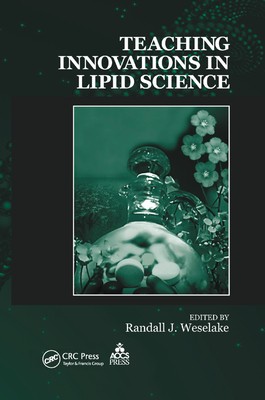
- We will send in 10–14 business days.
- Publisher: CRC Press
- ISBN-10: 0367388227
- ISBN-13: 9780367388225
- Format: 15.5 x 23.1 x 1.5 cm, minkšti viršeliai
- Language: English
- SAVE -10% with code: EXTRA
Teaching Innovations in Lipid Science (e-book) (used book) | bookbook.eu
Reviews
Description
Featuring practical strategies and exciting experiments, Teaching Innovations in Lipid Science addresses lipid education at a range of levels from the novice to the graduate student and teacher. Peer-reviewed contributions from internationally known specialists, describe several methods and approaches designed to create new lipid courses, modify existing courses, and serve as a basis for pursuing novel avenues of instruction.
Divided into two sections, the first focuses on teaching strategies and outlines some of the barriers that lipid science specialists face when transmitting accurate information. It emphasizes the development and implementation of creative programs that foster interest in lipid science, and presents novel problem-solving approaches. It discusses strategies for involving and evaluating independent study students and explains the successful use of sample cards to teach oilseed and cereal processing. This section also provides generalized accounts of biotechnology and crop improvement and isoprenoid biochemistry, including improvement of oilseed crops and tips on explaining DNA science and crop biotechnology.
The second section begins with simple demonstrations on the physical properties of lipids suitable for middle- and high school students. It follows with more complex experiments on analyzing lipids in food oils, plasma, and milk utilizing thin layer chromatography, gas chromatography, and high performance liquid chromatography. Contributions include information on convenient enzyme test kits with exercises that can translate to a lab course beginning with chromatographic methods for lipid analysis. The final chapter presents theory and experiments for studying lipid metabolism in the plastid by describing preparation methods, studying metabolite uptake, and pathway analysis.
EXTRA 10 % discount with code: EXTRA
The promotion ends in 21d.09:14:56
The discount code is valid when purchasing from 10 €. Discounts do not stack.
- Publisher: CRC Press
- ISBN-10: 0367388227
- ISBN-13: 9780367388225
- Format: 15.5 x 23.1 x 1.5 cm, minkšti viršeliai
- Language: English English
Featuring practical strategies and exciting experiments, Teaching Innovations in Lipid Science addresses lipid education at a range of levels from the novice to the graduate student and teacher. Peer-reviewed contributions from internationally known specialists, describe several methods and approaches designed to create new lipid courses, modify existing courses, and serve as a basis for pursuing novel avenues of instruction.
Divided into two sections, the first focuses on teaching strategies and outlines some of the barriers that lipid science specialists face when transmitting accurate information. It emphasizes the development and implementation of creative programs that foster interest in lipid science, and presents novel problem-solving approaches. It discusses strategies for involving and evaluating independent study students and explains the successful use of sample cards to teach oilseed and cereal processing. This section also provides generalized accounts of biotechnology and crop improvement and isoprenoid biochemistry, including improvement of oilseed crops and tips on explaining DNA science and crop biotechnology.
The second section begins with simple demonstrations on the physical properties of lipids suitable for middle- and high school students. It follows with more complex experiments on analyzing lipids in food oils, plasma, and milk utilizing thin layer chromatography, gas chromatography, and high performance liquid chromatography. Contributions include information on convenient enzyme test kits with exercises that can translate to a lab course beginning with chromatographic methods for lipid analysis. The final chapter presents theory and experiments for studying lipid metabolism in the plastid by describing preparation methods, studying metabolite uptake, and pathway analysis.


Reviews